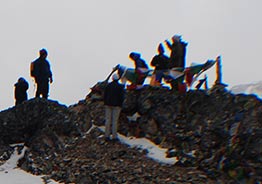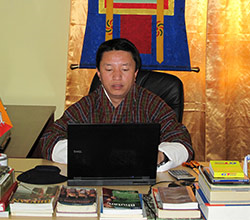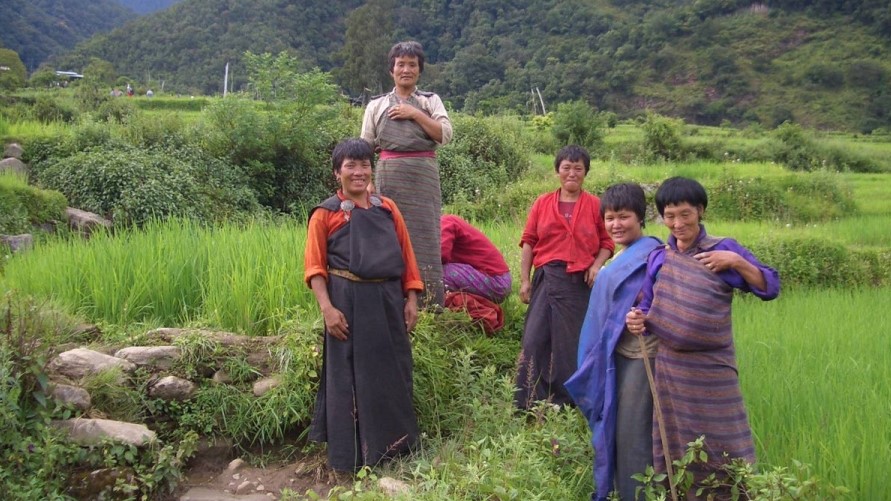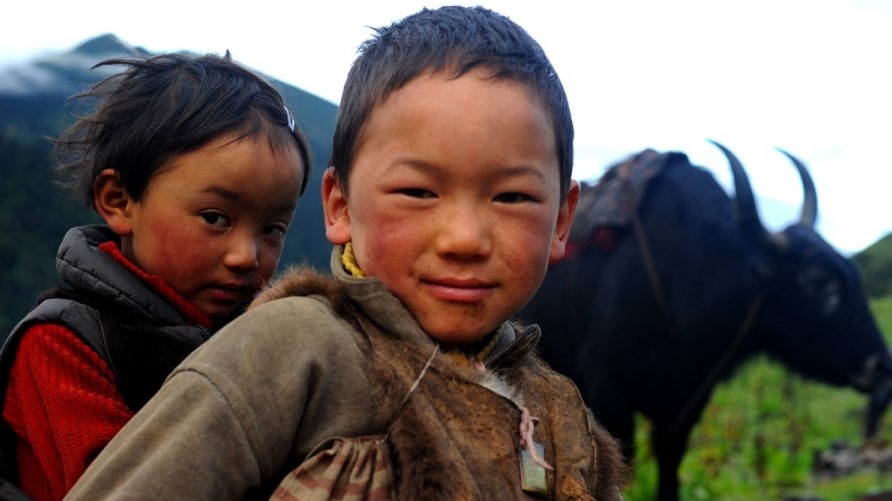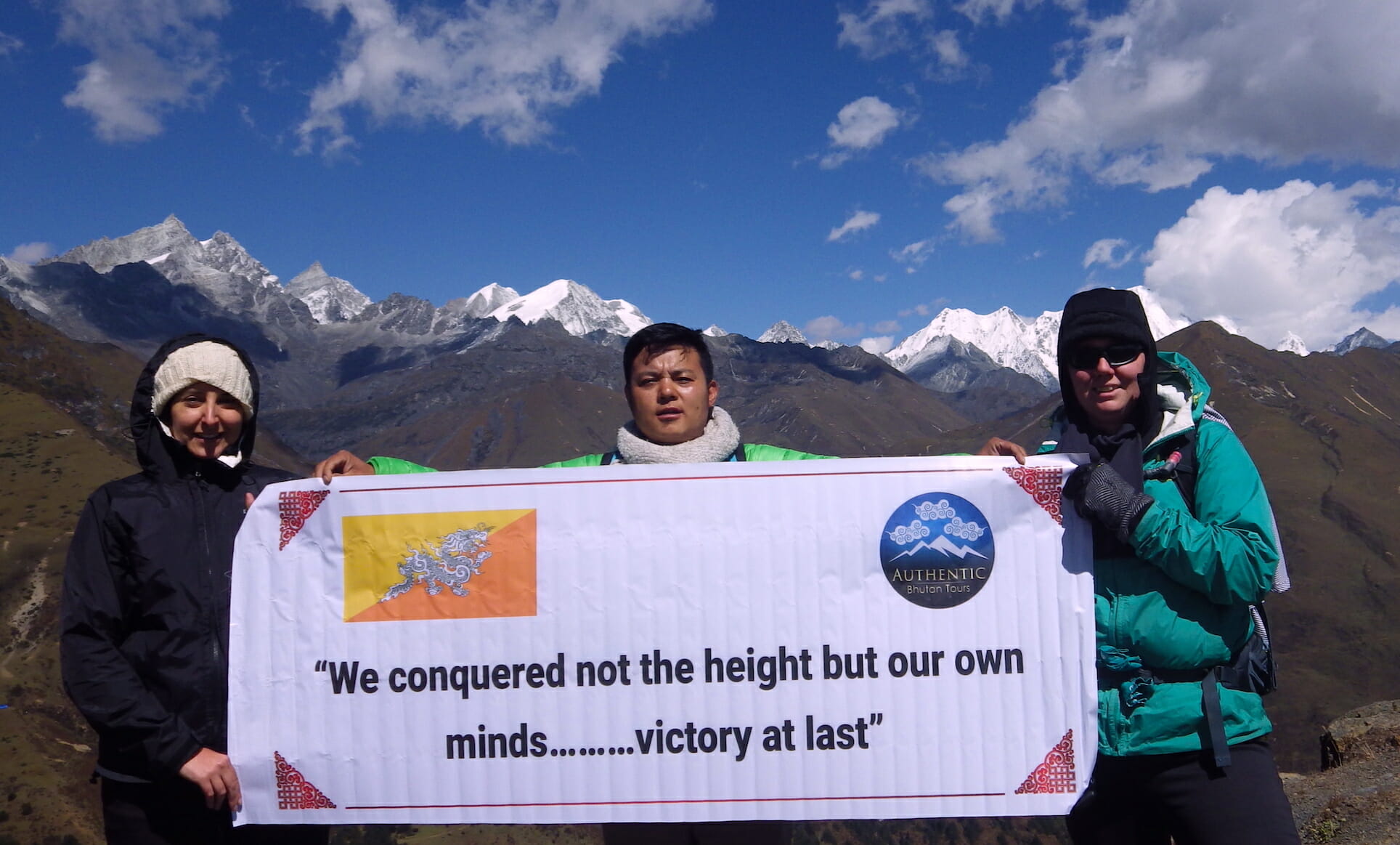The Term ‘Salt Route Trek’ is derived from the purpose it served prior to the construction of the national highway from Trashigang to Samdrup Jongkhar. The people of the Eastern Dzongkhags used to make voyages via this route to take salt and silk from the border town of Samdrup Jongkhar. This trek will take you through pristine broadleaved and pine forests with spectacular views of villages and mountains amidst the clouds. Although this Nature-based-trek route does not lead into really high altitudes, it is tough and involves long steep descents and ascents.
The Salt Route Trek in Bhutan offers an incredible opportunity to journey through both history and the Himalayan wilderness. This trek unravels the ancient trade routes that were once the lifeline for transporting precious salt between Trashigang and Samdrup Jongkhar.
As you embark on this remarkable expedition, you’ll be transported back in time, following in the footsteps of traders who navigated these trails centuries ago. The Salt Route Trek combines the thrill of adventure with the allure of cultural exploration, as you traverse rugged terrains, encounter remote villages, and engage with the local communities along the way.
The trek reveals a captivating tapestry of landscapes, ranging from towering mountain passes that unveil panoramic vistas to lush valleys, pristine lakes, and rhododendron-strewn forests. Amidst this natural beauty, you’ll find glimpses of traditional Bhutanese life, witnessing the customs and traditions that have been preserved over generations.
This journey isn’t just a physical trek; it’s an immersive experience that bridges the past and present, connecting you to the historical significance of these routes while allowing you to appreciate the raw, untouched beauty of Bhutan’s landscapes. The Salt Route Trek offers an unforgettable odyssey through time and terrain, a true testament to the resilience and interconnectedness of the cultures that shaped the Himalayan region.
Be the first travelers to take this journey, as this is new trek route, although it was used before the construction of national high way.
Trekking provides the best opportunity to experience and explore the real heart of Bhutan.
Discover a unique insight into the rural culture of the Kingdom of Bhutan.
Close contact with the people living in the remote areas of Bhutan.
Explore and appreciate the pristine environment of Bhutan.
Enjoy with the wilderness experiences in Bhutan.
Explore the adventure tours of Bhutan.
Enjoy with majestic views of the country’s virgin landscapes and unclimbed mountains.
Explore the routes taken by our ancestral.
Trekking through the beautiful lakes of Bhutan.
Day 01: Guahati (India)-Samdrupjongkhar (Bhutan)
Arrive at Guahati International Airport, receive the visitors and drive to Samdrup Jongkhar, the border town in Bhutan. It is a three hour drive. Visitors will have to halt for the night at Samdrup Jongkhar which is approximately 250m above the sea level. Samdrup Jongkhar is the main trading center for the population of the six eastern Dzongkhags and is famous for the traditional silk garments (Buray) produced there. These exquisitely made handicrafts are very popular amongst the Bhutanese and tourists alike.
Meal Plan: Welcome Dinner Accommodation: Hotel
Day 02: SamdrupJongkhar to Nelang (750 mtrs)
On the next day the visitors will have to drive two hours to reach Nelang, near Deothang from where the trek begins. The visitors can do a little bit of sightseeing in Samdrupjongkhar and explore the border town. They can also go across the border to the Indian town of Mela Bazar and do some shopping. Like any other border town all essential food items and garments are readily available.
Day 03. Nelang to Radingphu (686M)
The actual trek starts from Nelang downhill for about 45minutes till we reach the Duri river formed as a result of three streams namely Phudungri, Manchuri, Morongri. Once we reach Duri, the trek follows the river on a straight stretch for about two hours and will halt at Duktsiri for lunch. One of the significant aspects of this stretch is trekkers have to criss-cross Duri seven times on traditional log bridges until we reach Dutktseri which is the actual designated lunch Point.
After lunch the trek follows Duri River for another two hours here again the visitors will have to criss-cross the river six times on traditional log bridges before reaching Radingphu which is a perfect site to halt for the night. . Radingphu is a vast flat area, which can accommodate almost sixty to eighty tents with water facilities readily available. This is an ideal place for visitors who are interested in swimming and taking a splash in the river.
Note: It is very important to carry your own water, as there is no water on this stretch.
Day 04. Rangdingphu (686M) to Mongling (2218M)
From the base camp at Rangdingphu, there is a steep 3 hour climb to reach Dotak where the visitors can halt for lunch.. Dotak is situated on the border between Pemagatshel and Samdrupjongkhar.
After lunch the trek follows a steep climb for another two hours until we reach Mongling. On the way there is a place called zerim which is a flat grassy land shrouded by broad leaved trees. From Zerim we will be treated to a beautiful bird’s eye view of Deothang valley. From Zerim, the trek leads to a slow climb for about one hour from where the trail follows a straight stretch until we reach Regonpo on the base of Yonglaphu. There is a small spring at close proximity to Regonpo. From Regonpo the trek takes a straight stretch till we reach Mongling on the Tshelingkhor-Pemagatsel highway, which is an ideal location to rest for the night. Water is readily available at Mongling.
If the visitors wish to continue onwards and travel to Demrizam for the night halt, they can drive via the farm road. It is an hour drive from Mongling to Demrizam
Day 05. Mongling (2218M) to Demrizam (1191M)
The satellite town of Kherigonpa is half an hour drive from Mongling. From Mongling we get a beautiful bird’s eye view of some portion of Pemagatshel and Deothang. The stretch between Mongling to Demrizam is a slow descent crossing the farm road several times. From Mongling, the visitors if they wish can visit Yongla Gonpa.
Yongla Gonpa observes it annual religious ceremony known as Jali Phurpa presided by Yongla Lam. The religious ceremony is accompanied by mask dances and folk dances performed by both monks and layman. The other religious site to visit is the Jangchup Chorten constructed by Rangshikhar Lam.
Day 06. Demri Zam (1191M) to Denchung ((1231M)
Demrizam was traditionally where traders stopped to rest for the night in the past.. Water is readily available and the river provides an ideal place to enjoy some r swimming and fishing. Fishing however requires permits that your travel operators can arrange for you.
It will be necessary for trekkers to carry their own water as there is no water on this stretch of the trek. The Campsite at Demri Zam has been cleared properly and water facilities are readily available. The next day the trek ascends in a slow climb until we reach Tsatshi Danri for the lunch break.
After lunch we will begin a steep descent to reach the Tonglingdrang Suspension Bridge. From here on it is a gradual ascent and straight stretch to Denchung by the side of the Khaling River where we will camp for the night. . The Denchung Campsite has been properly cleared but water should be collected from the nearby river approximately 100meters away.
Day 07. Denchung (1231M) to Cheya (1442 M)
From Denchung the trek follows the Khaling River for a little more than two hours where we reach Liza for lunch. After lunch the trek follows a steep ascent through beautiful pine forests until we reach Cheya. The stretch from Denchung to Cheya will probably be the most difficult section of the trek as the path is steeply climb. The campsite at Cheya is very beautiful near the Cheya Tsho (lake). from which water is also readily available.
Day 08. Cheya (1442 M) to Trashigang
The last day of the trek will be from Cheya to Trashigang. There are two options: visitors can either ride to Trasghigang form Cheya via Khengthogmani or they can trek from Cheya to Khegthnogmani and take a ride from Khentongmani. Since the trek follows the farm road it is advisable that the vehicles move to Cheya Tsho for boarding of the visitors. Dinner and overnight stay at Hotel Trashigang. Hotel Deojung or similar standar.
Day 09. Trashigang stay.
Today we will explore Rangjung and Radhi villages with picnic lunch. At Rangjung, we will visit to Rangjung Osel Chholing Monastery. At Kardung, we will visit to Khardung Animi Dratshang and learn their way of life. Lunch served as hot picnic lunch. Enjoy the rice bowl valley (Radhi Valley) of eastern Bhutan. Evening at leisure and dinner and overnight stay at hotel Trashigang.
Day 10. Trashigang – Mongar via Trashi Yangtshi.
Today we will drive to Mongar after doing the sightseeing in Trashi Yangtshi. At Trashi Yangtshi, visit to Chhorten Kora, designed similar to Nepal’s Boudhanath stupa and old dzong. Then drive back and visit to Gomphu Kora, one of the most important pilgrimage places in eastern Bhutan. Then continue our journey to Mongar.
At Ngathsang, visit to Ngatshang Monastery and explore and learn the monk’s life in Bhutan. Lunch picnic lunch on the way or at local restaurant on the way. On reaching Mongar, we will visit to Mongar Dzong, was established in 1930 to replace the original Zhongar Dzong. Evening stroll around Mongar Town. Dinner and over night stay at Mongar Hotel. Hotel Drukzom or similar standard.
Day 11. Mongar – Samdrup Jongkhar
Drive to Samdrup Jongkhar. You will have lot of opportunities for you photo shoot and stop where every necessary. We will visit to Kanglung Zangtopleri Lhakhang and Khaling Handloom Center.
We will have picnic lunch or at local restaurant on the way. On reaching Samdrup Jongkhar, our guide will completed the immigration formalities for your tomorrow’s departure to Guwahati. In the evening, you will meet the Indian driver, who will take you to Guwahati Airport tomorrow.
Your Bhutanese guide and driver will bid you farewell at today’s dinner time as they will leave to Thimphu very early morning, next day.
Day 12. Samdrup Jongkhar – Guwhati.
Today after your breakfast, your Indian driver and car will take you to Guwahati airport. We wish you a very safe and comfortable journey back to your country. Thank you very much visiting Bhutan through our company and we hope to see you again in Bhutan some day.
Start planning your tailor-made Dream Holiday to Bhutan – The Land of happiness!
In order to experience the best and rewarding fulfillment clients must plan in advance the different logistics that you have in your minds before actually venturing into the world of trips. You might have wishes and hopes for which you need to plan.
The following information will help you to plan your dream trip to Bhutan.
1. When and how to visit Bhutan?
Choose your traveling date like Arrival/Departure date. You also need to choose entry/depart Bhutan via AIR or LAND.
By Air: Druk Air, the national carriers is the only service operator in the kingdom and operates several flights per week from Bangkok (Thailand), Delhi & Kolkata (India) and Kathmandu (Nepal) to Paro (Bhutan). The Paro International Airport is located about an hour and a half drive from Thimphu, the capital city of Bhutan.
Paro airport is daylight restricted, and the flights are totally dependent on the weather. As a result, sometimes flights are delayed. It is therefore a good idea to keep at least 24 hours of transit time for connecting flights out of Paro. You might also want to consider traveling on a non-restricted ticket so that if you miss a connecting flight, you can be rerouted or seated on the first available carrier.
Sometimes flights into Paro are disrupted because of unfavorable weather conditions. If this occurs, the flight will stop for the night at the transit airport. To be prepared, you may want to carry your essential personal items in your carry-on luggage.
By Land: Phuentsholing, a Bhutanese town in the southwest has road access to India. It is located about 170 km from the Indian domestic airport at Bagdogra, West Bengal. Phuentsholing is about 172 km from Thimphu the capital city of Bhutan and is about 6hours drive distance. And S/
2. What are your itineraries?
All the tours can be customized and extended as per our valued client’s requirements. There are sample itineraries for your kind reference and it will give you some general idea of the likely trip scheduled.
Complete the tour request form and submit it to us. Send us correct name list. We will send you the flight reservation status via email.
After confirming your reservation, we need the scanned copy of member’s passport.
Please remit us full payments and send us the copy of remittance paper via email. Visa will not be accepted without full payment.
We will send you the flight ticket copy and Visa Clearance Copy prior to your departure to Bhutan via email. You need to print out and carry along with you.
Start packing and looking forward to have a memorable trip in the LandThunder Dragon, DrukYul.
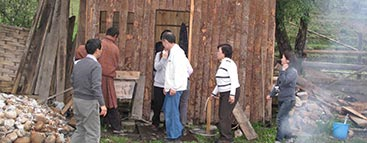
Hot stone bath (Dhotsho) is a traditional bath of Bhutan, where a tradition of heating up stones and then soaking in the water that is in turn heated by the stones. This is also a curative method and is used throughout the country We Bhutanese belief that this bath has so much of medicinal benefits. Some diseases are curable-like joint pains, hypertension, stomach disorder, arthritis and many other minor diseases. Especially for the old age, where we have lots of body pains, joints pains helps a lot by this Hot Stone Bath (Dhotsho).
I think, the minerals in the rocks have certain chemicals, which can cure certain disease of our body. Hot stone bath has no side effects. It is in its pure natural form. We can organize the hot stone bath during your stay in Bhutan.
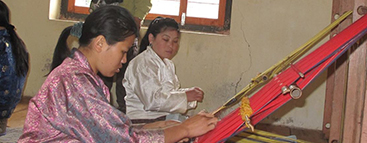
The Bhutanese textiles are rich, vibrant, and colorful and are a complex art form as well as an integral part of the Bhutanese culture. This Bhutan weaving experiences will give you an insight about the rich textiles in Bhutan. You can sit one of the handlooms of Bhutan and weave your self practically. We promise that you will really enjoy this with great satisfaction in your life.
We will also see or learn the natural coloring and dyeing. You can bring your own materials like handkerchief to dye and color. So visit Bhutan and experience it practically by yourself.
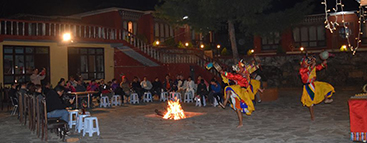
Folk Performing Arts & Music in the Himalayan Kingdom of Bhutan
We have Cultural Program Performing groups, which they will perform like Traditional folk songs, dances and keeps original tunes and dances alive. Moreover, new choreography for some traditional and regional songs is sometimes developed.
The troupe also performs mask dances that have historical and spiritual significance.
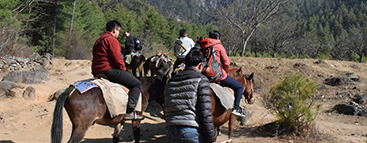
Tiger’s Nest is most visited spot in Bhutan and it is much awaited by every tourist who visits Bhutan to climb to Tiger’s Nest.
It takes about 2 hrs 30mins up steep climb through the forest of pine, oak and Rhododendron. However you can ride the horse and climb till the Taktshang cafeteria.
Our company will provide the Trekking Equipment like Tents (Sleeping, Dinning, Toilet, Shower Tents), Mattress, Hot-Water bag, Cooking Utensils, Sleeping Bags. But we advise our clients to bring their own sleeping bags, if they can. However our guests have to bring some trekking gears by themselves. Therefore, everything mentioned below on the list are useful, and most of the things are important on trek.
Equipment for all the trekkers
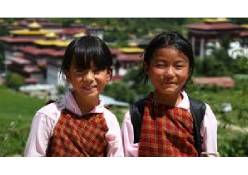
Footwear
camp shoes or thongs
socks – polypropylene
Clothing
jumper or pile jacket
hiking shorts (men) or skirt (opt)
waterproof jacket, poncho or umbrella
hiking pants
T- shirts or blouses
underwear, sun hat
swimwear (opt.)
insulated paints
nylon wind breaker
nylon wind pants
long underwear
woolen hat
gloves
long gaiters
Above 4000 m.
socks, wool, to wear with boots
socks, light cotton, for under wool socks
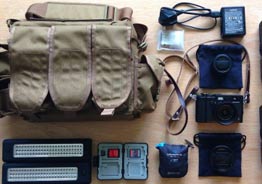
Photography Equipments
( Optional )
lenses cleaning equipments
film
compass
thermometer
binoculars
books for reading while waiting for plane
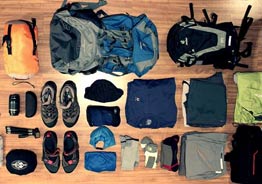
Other Equipments
sleeping bag
water bottle
torch
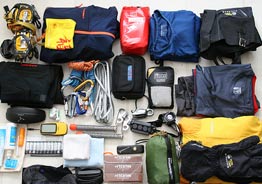
Miscellaneous Items
toilet paper and cigarette lighter
small knife
sun block
towel
laundry soap
medical and frist aid kit
pre-moistened towelettes
sewing kit
sunglasses
sun block for lips




